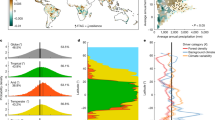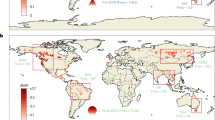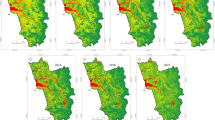Abstract
Forest gains and losses may have unequal effects on forest resilience, particularly given their distinct temporal dynamics. Here, we quantify the sensitivities of boreal forest resilience to forest cover gain and loss using a resilience indicator derived from the temporal autocorrelation (TAC) of the kernel normalized difference vegetation index from 2000 to 2020. Our findings unveil pronounced asymmetric sensitivities, with stronger sensitivity to forest loss (−4.26 ± 0.14 × 10−3; TAC increase per 1% forest cover loss) than to forest gain (−1.65 ± 0.12 × 10−3; TAC decrease per 1% forest cover gain). Locally, ~73% of the boreal forest exhibits negative sensitivity, indicating enhanced resilience with forest cover gain and vice versa, especially in intact forests compared to managed ones. This sensitivity is affected by various trajectories in forest cover change, stemming primarily from temporal asynchrony in the recovery rates of various ecosystem functions. The observed asymmetry underscores the importance of prioritizing forest conservation over reactive management strategies following losses, ultimately contributing to more sustainable forest management practices.
This is a preview of subscription content, access via your institution
Access options
Access Nature and 54 other Nature Portfolio journals
Get Nature+, our best-value online-access subscription
$32.99 / 30 days
cancel any time
Subscribe to this journal
Receive 12 digital issues and online access to articles
$119.00 per year
only $9.92 per issue
Buy this article
- Purchase on SpringerLink
- Instant access to full article PDF
Prices may be subject to local taxes which are calculated during checkout



Similar content being viewed by others
Data availability
The Köppen–Geiger world map is available at http://koeppen-geiger.vu-wien.ac.at/present.htm. NDVI data were sourced from the MOD13C1V6 product at https://lpdaac.usgs.gov/products/mod13c1v006/ (ref. 59). Forest cover fraction data were obtained from the MOD44BV6 product at https://lpdaac.usgs.gov/products/mod44bv006/ (ref. 60). VOD data were acquired from the VOD Climate Archive (VODCA) via Zenodo at https://zenodo.org/records/2575599 (ref. 71). Land-cover data were available from the ESA CCI at https://maps.elie.ucl.ac.be/CCI/viewer/download.php. The global forest management data are available via Zenodo at https://zenodo.org/records/5879022 (ref. 72). The PFT data were attained from the MCD12C1V6 product at https://lpdaac.usgs.gov/products/mcd12c1v006/ (ref. 61). GPP data were acquired from the MOD17A2HV6 product at https://lpdaac.usgs.gov/products/mod17a2hv006/ (ref. 62). The climate datasets are available from the ERA5-Land reanalysis product at https://cds.climate.copernicus.eu/datasets/reanalysis-era5-land-monthly-means?tab=download.
Code availability
The custom MATLAB (R2023a) scripts written to analyse the data and generate figures are available via Figshare at https://figshare.com/projects/Asymmetric_sensitivity_of_boreal_forest_resilience_to_forest_gain_and_loss/208609 (ref. 73).
References
Global Forest Resources Assessment 2020 (FAO, 2020).
Brandt, J. P., Flannigan, M. D., Maynard, D. G., Thompson, I. D. & Volney, W. J. A. An introduction to Canada’s boreal zone: ecosystem processes, health, sustainability, and environmental issues. Environ. Rev. 21, 207–226 (2013).
Gauthier, S., Bernier, P., Kuuluvainen, T., Shvidenko, A. Z. & Schepaschenko, D. G. Boreal forest health and global change. Science 349, 819–822 (2015).
Pan, Y. et al. A large and persistent carbon sink in the world’s forests. Science 333, 988–993 (2011).
Holling, C. S. Resilience and stability of ecological systems. Annu. Rev. Ecol. Syst. 4, 1–23 (1973).
Forzieri, G., Dakos, V., McDowell, N. G., Ramdane, A. & Cescatti, A. Emerging signals of declining forest resilience under climate change. Nature 608, 534–539 (2022).
Dietrich, P. et al. Plant diversity and community age stabilize ecosystem multifunctionality. Glob. Change Biol. 30, e17225 (2024).
Xu, Q. et al. Consistently positive effect of species diversity on ecosystem, but not population, temporal stability. Ecol. Lett. 24, 2256–2266 (2021).
Loreau, M. & de Mazancourt, C. Biodiversity and ecosystem stability: a synthesis of underlying mechanisms. Ecol. Lett. 16, 106–115 (2013).
Rotbarth, R. et al. Northern expansion is not compensating for southern declines in North American boreal forests. Nat. Commun. 14, 3373 (2023).
Palmero-Iniesta, M., Pino, J., Pesquer, L. & Espelta, J. M. Recent forest area increase in Europe: expanding and regenerating forests differ in their regional patterns, drivers and productivity trends. Eur. J. For. Res. 140, 793–805 (2021).
Achard, F. et al. Areas of rapid forest-cover change in boreal Eurasia. For. Ecol. Manag. 237, 322–334 (2006).
Whitman, E., Parisien, M.-A., Thompson, D. K. & Flannigan, M. D. Short-interval wildfire and drought overwhelm boreal forest resilience. Sci. Rep. 9, 18796 (2019).
Runyan, C. & D’Odorico, P. Global Deforestation (Cambridge Univ. Press, 2016).
Zhang, J., Fu, B., Stafford-Smith, M., Wang, S. & Zhao, W. Improve forest restoration initiatives to meet Sustainable Development Goal 15. Nat. Ecol. Evol. 5, 10–13 (2021).
Hua, F. et al. The biodiversity and ecosystem service contributions and trade-offs of forest restoration approaches. Science 376, 839–844 (2022).
Feng, Y. et al. Multispecies forest plantations outyield monocultures across a broad range of conditions. Science 376, 865–868 (2022).
Su, Y. et al. Asymmetric influence of forest cover gain and loss on land surface temperature. Nat. Clim. Change 13, 823–831 (2023).
Lemprière, T. C. et al. Canadian boreal forests and climate change mitigation. Environ. Rev. 21, 293–321 (2013).
De Keersmaecker, W. et al. A model quantifying global vegetation resistance and resilience to short‐term climate anomalies and their relationship with vegetation cover. Glob. Ecol. Biogeogr. 24, 539–548 (2015).
Camps-Valls, G. et al. A unified vegetation index for quantifying the terrestrial biosphere. Sci. Adv. 7, eabc7447 (2021).
Berner, L. T. & Goetz, S. J. Satellite observations document trends consistent with a boreal forest biome shift. Glob. Change Biol. 28, 3275–3292 (2022).
Alix-Garcia, J. et al. Drivers of forest cover change in Eastern Europe and European Russia, 1985–2012. Land Use Policy 59, 284–297 (2016).
Lesiv, M. et al. Global forest management data for 2015 at a 100 m resolution. Sci. Data 9, 199 (2022).
Thompson, I., Mackey, B., McNulty, S. & Mosseler, A. Forest Resilience, Biodiversity, and Climate Change (Secretariat of the Convention on Biological Diversity, 2009).
Cook-Patton, S. C. et al. Protect, manage and then restore lands for climate mitigation. Nat. Clim. Change 11, 1027–1034 (2021).
Smith, T. & Boers, N. Reliability of vegetation resilience estimates depends on biomass density. Nat. Ecol. Evol. 7, 1799–1808 (2023).
Moesinger, L. et al. The global long-term microwave Vegetation Optical Depth Climate Archive (VODCA). Earth Syst. Sci. Data 12, 177–196 (2020).
Land Cover CCI Product User Guide Version 2 (ESA, 2017).
De Keersmaecker, W. et al. How to measure ecosystem stability? An evaluation of the reliability of stability metrics based on remote sensing time series across the major global ecosystems. Glob. Change Biol. 20, 2149–2161 (2014).
Smith, T., Traxl, D. & Boers, N. Empirical evidence for recent global shifts in vegetation resilience. Nat. Clim. Change 12, 477–484 (2022).
Dakos, V., Nes van, E. H., D’Odorico, P. & Scheffer, M. Robustness of variance and autocorrelation as indicators of critical slowing down. Ecology 93, 264–271 (2012).
Smith, T. & Boers, N. Global vegetation resilience linked to water availability and variability. Nat. Commun. 14, 498 (2023).
Seddon, A. W. R., Macias-Fauria, M., Long, P. R., Benz, D. & Willis, K. J. Sensitivity of global terrestrial ecosystems to climate variability. Nature 531, 229–232 (2016).
Feng, Y. et al. Reduced resilience of terrestrial ecosystems locally is not reflected on a global scale. Commun. Earth Environ. 2, 88 (2021).
Trumbore, S., Brando, P. & Hartmann, H. Forest health and global change. Science 349, 814–818 (2015).
Asner, G. P., Keller, M., Pereira, R. Jr., Zweede, J. C. & Silva, J. N. M. Canopy damage and recovery after selective logging in Amazonia: field and satellite studies. Ecol. Appl. 14, 280–298 (2004).
Rangel Pinagé, E. et al. Long-term impacts of selective logging on Amazon forest dynamics from multi-temporal airborne LiDAR. Remote Sens. 11, 709 (2019).
Milodowski, D. T. et al. The impact of logging on vertical canopy structure across a gradient of tropical forest degradation intensity in Borneo. J. Appl. Ecol. 58, 1764–1775 (2021).
Aerts, R. & Honnay, O. Forest restoration, biodiversity and ecosystem functioning. BMC Ecol. 11, 29 (2011).
Bongers, F. J. et al. Functional diversity effects on productivity increase with age in a forest biodiversity experiment. Nat. Ecol. Evol. 5, 1594–1603 (2021).
Guerrero-Ramírez, N. R. et al. Diversity-dependent temporal divergence of ecosystem functioning in experimental ecosystems. Nat. Ecol. Evol. 1, 1639–1642 (2017).
Zhang, Y. et al. Asymmetric impacts of forest gain and loss on tropical land surface temperature. Nat. Geosci. 17, 426–432 (2024).
Shorohova, E., Kneeshaw, D., Kuuluvainen, T. & Gauthier, S. Variability and dynamics of old-growth forests in the circumboreal zone: implications for conservation, restoration and management. Silva. Fenn. 45, 785–806 (2011).
Mushinski, R. M., Boutton, T. W. & Scott, D. A. Decadal-scale changes in forest soil carbon and nitrogen storage are influenced by organic matter removal during timber harvest. J. Geophys. Res. Biogeosci. 122, 846–862 (2017).
Prest, D., Kellman, L. & Lavigne, M. B. Mineral soil carbon and nitrogen still low three decades following clearcut harvesting in a typical Acadian Forest stand. Geoderma 214–215, 62–69 (2014).
DellaSala, D. A. Temperate and Boreal Rainforests of the World: Ecology and Conservation (Island Press, 2011).
Watson, J. E. M. et al. The exceptional value of intact forest ecosystems. Nat. Ecol. Evol. 2, 599–610 (2018).
Legislation from British Columbia government to halt logging in Great Bear Rainforest. The Great Bear Rainforest Agreement (Government of British Columbia, 2016); www2.gov.bc.ca/gov/content/environment/natural-resource-stewardship/great-bear-rainforest/gbr-agreement-highlights?keyword=great&keyword=bear&keyword=rainforest/
Reyer, C. P. O. et al. Forest resilience and tipping points at different spatio-temporal scales: approaches and challenges. J. Ecol. 103, 5–15 (2015).
Ibáñez, I. et al. Forest resilience under global environmental change: do we have the information we need? A systematic review. PLoS ONE 14, e0222207 (2019).
Oliveira, B. F., Moore, F. C. & Dong, X. Biodiversity mediates ecosystem sensitivity to climate variability. Commun. Biol. 5, 628 (2022).
Johnstone, J. et al. Fire, climate change, and forest resilience in interior Alaska. Can. J. For. Res. 40, 1302–1312 (2010).
Hollingsworth, T. N., Johnstone, J. F., Bernhardt, E. L. & Iii, F. S. C. Fire severity filters regeneration traits to shape community assembly in Alaska’s boreal forest. PLoS ONE 8, e56033 (2013).
Kelly, R. et al. Recent burning of boreal forests exceeds fire regime limits of the past 10,000 years. Proc. Natl Acad. Sci. USA 110, 13055–13060 (2013).
Girardin, M. P. & Terrier, A. Mitigating risks of future wildfires by management of the forest composition: an analysis of the offsetting potential through boreal Canada. Clim. Change 130, 587–601 (2015).
Zheng, B. et al. Record-high CO2 emissions from boreal fires in 2021. Science 379, 912–917 (2023).
Kottek, M., Grieser, J., Beck, C., Rudolf, B. & Rubel, F. World map of the Köppen–Geiger climate classification updated. Meteorol. Z. 15, 259–263 (2006).
Didan, K. MODIS/Terra Vegetation Indices 16-Day L3 Global 0.05Deg CMG V006 (Data set) (2015) (NASA EOSDIS Land Processes DAAC, accessed February 2023); https://doi.org/10.5067/MODIS/MOD13C1.006
DiMiceli, C. et al. MODIS/Terra Vegetation Continuous Fields Yearly L3 Global 250m SIN Grid V006 (Data set) (2015) (NASA EOSDIS Land Processes DAAC, accessed February 2023); https://doi.org/10.5067/MODIS/MOD44B.006
Friedl, M. & Sulla-Menashe, D. MODIS/Terra+Aqua Land Cover Type Yearly L3 Global 0.05Deg CMG V006 (Data set) (2015) (NASA EOSDIS Land Processes DAAC, accessed March 2023); https://doi.org/10.5067/MODIS/MCD12C1.006
Running, S., Mu, Q. & Zhao, M. MODIS/Terra Gross Primary Productivity 8-Day L4 Global 500m SIN Grid V006 (Data set) (2015) (NASA EOSDIS Land Processes DAAC, accessed February 2023); https://doi.org/10.5067/MODIS/MOD17A2H.006
Muñoz-Sabater, J. et al. ERA5-Land: a state-of-the-art global reanalysis dataset for land applications. Earth Syst. Sci. Data 13, 4349–4383 (2021).
Tugade, M. M. & Fredrickson, B. L. Resilient individuals use positive emotions to bounce back from negative emotional experiences. J. Pers. Soc. Psychol. 86, 320–333 (2004).
Barrett, C. B. & Constas, M. A. Toward a theory of resilience for international development applications. Proc. Natl Acad. Sci. USA 111, 14625–14630 (2014).
Folke, C. Resilience (republished). Ecol. Soc. 21, 44 (2016).
Ives, A. R. & Carpenter, S. R. Stability and diversity of ecosystems. Science 317, 58–62 (2007).
Scheffer, M. et al. Early-warning signals for critical transitions. Nature 461, 53–59 (2009).
Dakos, V. et al. Slowing down as an early warning signal for abrupt climate change. Proc. Natl Acad. Sci. USA 105, 14308–14312 (2008).
Scheffer, M., Carpenter, S. R., Dakos, V. & van Nes, E. H. Generic indicators of ecological resilience: inferring the chance of a critical transition. Annu. Rev. Ecol. Evol. Syst. 46, 145–167 (2015).
Moesinger, L. et al. The global long-term microwave vegetation optical depth climate archive VODCA (1.0) [Data set]. Zenodo https://doi.org/10.5281/zenodo.2575599 (2019).
Lesiv, M. et al. Global forest management data at a 100 m resolution for the year 2015 [Data set]. In Nature Scientific Data (Version 3). Zenodo https://doi.org/10.5281/zenodo.5879022 (2021).
Liu, X. Raw data [Dataset]. Figshare https://doi.org/10.6084/m9.figshare.27329979.v1 (2024).
Acknowledgements
This study was supported by the National Natural Science Foundation of China—United Nations Environment Programme (grant no. 42361144001 to Z.Z.), National Natural Science Foundation of China (42371026 to D.W. and 42071022 to Z.Z.), Shenzhen Science and Technology Project for Sustainable Development in Special Innovation (KCXFZ20230731093403008 to Z.Z., D.W. and X.L.) and the start-up and high-level special funds provided by the Southern University of Science and Technology (29/Y01296602, 29/Y01296122, 29/Y01296222 and G030290001 to Z.Z.). A.C. acknowledges support from an Oak Ridge National Lab subcontract (CW53561). We thank the Center for Computational Science and Engineering at the Southern University of Science and Technology for providing computing resources.
Author information
Authors and Affiliations
Contributions
Z.Z. and D.W. designed the research. X.L. performed the analysis and wrote the first draft. All authors contributed to the interpretation of the results and the revising of the paper.
Corresponding authors
Ethics declarations
Competing interests
The authors declare no competing interests.
Peer review
Peer review information
Nature Ecology & Evolution thanks Mukund Rao, Ronny Rotbarth and the other, anonymous, reviewer(s) for their contribution to the peer review of this work. Peer reviewer reports are available.
Additional information
Publisher’s note Springer Nature remains neutral with regard to jurisdictional claims in published maps and institutional affiliations.
Extended data
Extended Data Fig. 1 Spatial distribution of target and control pixels over boreal regions.
a, Spatial map of the distribution of target pixels and control pixels exhibiting no discernible forest cover (FC) change. b, A zoomed-in view of a 1° × 1° spatial window used for extracting ΔTAC, with the target pixel (green) located at the center with reference pixels (red; both at 0.05° × 0.05° resolution) scattering around it. c, Probability distribution frequency of the number of control pixels within the corresponding 1° × 1° spatial windows.
Extended Data Fig. 2 Asymmetric impacts of boreal forest cover change on resilience derived from alternative datasets and methods.
Each row corresponds to one alternative data or method: VOD as the state variable for the forest ecosystem to construct TAC (a, b), ESA CCI land cover product as an alternative dataset to derive forest cover fraction (c, d), variance as an alternative resilience indicator (e, f), 3-order harmonic deseasoner with rolling mean detrender as complementary pre-processing approaches (g, h). Bars in panels a, c, e and g indicate the mean ΔTAC weighted by pixel areas, with error bars representing the 95% confidence interval of the mean ΔTAC. ΔFC values in panel a were divided into 40 bins with 0.5% intervals, while in panels c, e and g, they were divided into 25 bins with 2% intervals. Bars in panels b, d, f and h indicate the linear regression coefficient, with error bars representing the 95% confidence interval. Brown and magenta numbers in panels indicate the sample size of forest loss pixels, while green numbers indicate the sample size of forest gain pixels.
Extended Data Fig. 3 Comparative analysis of forest resilience and its sensitivity to forest cover change under different plant function types (PFTs).
a, Distribution of resilience (long-term TAC) among PFTs. Box plots illustrate the median TAC with its 25th and 75th percentiles. The double asterisks (**) indicate statistically significant differences in the medians between each pair of types (two-sided Mann-Whitney U test; p < 0.01). b, Regional sensitivity of resilience to forest cover change among PFTs. The regional sensitivity is determined by regressing ΔTAC against ∆FC across the entire boreal region. Bars denote the regression coefficient, with error bars representing the 95% confidence interval for the coefficient. The double asterisks (**) indicate statistically significant differences in the regression coefficients between each pair of types (two-sided Wald test; p < 0.01). c, Distribution of local sensitivity, determined by regressing ΔTAC against ∆FC in a 1° × 1° spatial window surrounding the target pixel. Box plots illustrate the median TAC with its 25th and 75th percentiles. The double asterisks (**) indicate statistically significant differences in the medians between each pair of types (two-sided Mann-Whitney U test; p < 0.01). Numbers in panels a-c represent the sample size (pixels) of each forest type.
Supplementary information
Rights and permissions
Springer Nature or its licensor (e.g. a society or other partner) holds exclusive rights to this article under a publishing agreement with the author(s) or other rightsholder(s); author self-archiving of the accepted manuscript version of this article is solely governed by the terms of such publishing agreement and applicable law.
About this article
Cite this article
Liu, X., Wang, D., Chen, A. et al. Asymmetric sensitivity of boreal forest resilience to forest gain and loss. Nat Ecol Evol 9, 505–514 (2025). https://doi.org/10.1038/s41559-024-02631-1
Received:
Accepted:
Published:
Issue date:
DOI: https://doi.org/10.1038/s41559-024-02631-1



